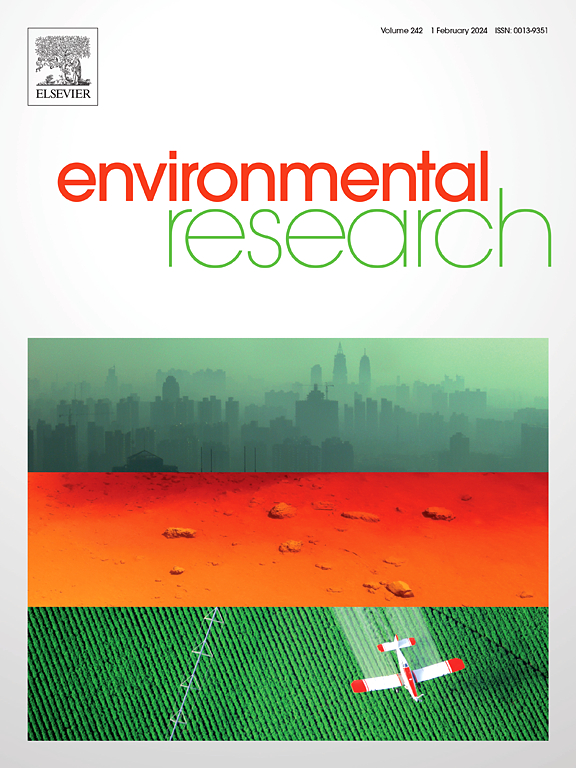Unraveling the hidden pathways: Bioaccumulation and metabolism of atrazine, acetochlor, and metolachlor in aquatic organisms
IF 7.7
2区 环境科学与生态学
Q1 ENVIRONMENTAL SCIENCES
引用次数: 0
Abstract
Atrazine (ATZ), acetochlor (ACE), and metolachlor (MET) are widely used herbicides whose residues persist in the environment, contributing to the mixed pollution of aquatic ecosystems. However, the mechanisms underlying their environmental behavior and biological effects remain poorly understood. In this study, we systematically investigated the transfer, bioaccumulation, and elimination of ATZ, ACE, and MET in fish (Procypris merus) under single and combined exposure conditions. The results indicate that after exposure in water, ATZ, ACE, and MET extensively accumulate in the muscle tissue of P. merus, accounting for 71 %–84 % of the total pesticide accumulation, making it the primary storage site for these herbicides. Under mixed exposure conditions, the three herbicides exhibited time-dependent synergistic toxic effects. Combined exposure to ATZ, ACE, and MET significantly increased the concentrations of ATZ and ACE in the liver, as well as the Kup and BCF of ACE and MET. During the purification and detoxification phases, the gills exhibited the highest purification rate, nearly twice that of the intestines and liver. The distribution of herbicides in various tissues was positively correlated with hydrophobicity (log Kow) and lipid content. Using UPLC-ESI-QTOF-MS/MS, the metabolites of ATZ, ACE, and MET were identified and analyzed. The three pesticides were primarily metabolized in the lotus carp through dealkylation, hydroxylation, and conjugation with glutathione/glucose. A total of 9 ATZ metabolites, 11 ACE metabolites, and 10 MET metabolites were identified, 19 of which were detected in fish for the first time. rac-MET displayed distinct stereoselective behavior, with the liver preferentially enriching the 1′S, α′R-MET isomer. This study provides a robust dataset for understanding the environmental and dietary risks of the target herbicides associated with residues that persist for prolonged periods.
揭示隐藏的途径:阿特拉津、乙草胺和甲草胺在水生生物中的生物积累和代谢。
莠去津(ATZ)、乙草胺(ACE)和异甲草胺(MET)是广泛使用的除草剂,其残留在环境中,造成了水生生态系统的混合性污染。然而,它们的环境行为和生物效应背后的机制仍然知之甚少。在这项研究中,我们系统地研究了ATZ、ACE和MET在单一和联合暴露条件下在鱼(Procypris merus)体内的转移、生物积累和消除。结果表明,在水中暴露后,ATZ、ACE和MET在海鲈肌肉组织中大量积累,占总农药积累量的71% ~ 84%,是海鲈肌肉组织中这些除草剂的主要储存场所。在混合暴露条件下,三种除草剂表现出时间依赖性的协同毒性效应。ATZ、ACE和MET联合暴露显著增加了肝脏中ATZ和ACE的浓度,以及ACE和MET的Kup和BCF。在纯化和解毒阶段,鳃的纯化率最高,几乎是肠道和肝脏的两倍。除草剂在各组织中的分布与疏水性(log Kow)和脂质含量呈正相关。采用UPLC-ESI-QTOF-MS/MS对ATZ、ACE和MET的代谢产物进行鉴定和分析。这三种农药主要通过脱烷基、羟基化和谷胱甘肽/葡萄糖的结合在莲鱼体内代谢。共鉴定出9种ATZ代谢物、11种ACE代谢物和10种MET代谢物,其中19种为首次在鱼类中检测到。rac-MET表现出明显的立体选择性行为,肝脏优先富集1'S, α'R-MET异构体。本研究为了解目标除草剂与长期残留相关的环境和饮食风险提供了可靠的数据集。
本文章由计算机程序翻译,如有差异,请以英文原文为准。
求助全文
约1分钟内获得全文
求助全文
来源期刊

Environmental Research
环境科学-公共卫生、环境卫生与职业卫生
CiteScore
12.60
自引率
8.40%
发文量
2480
审稿时长
4.7 months
期刊介绍:
The Environmental Research journal presents a broad range of interdisciplinary research, focused on addressing worldwide environmental concerns and featuring innovative findings. Our publication strives to explore relevant anthropogenic issues across various environmental sectors, showcasing practical applications in real-life settings.
 求助内容:
求助内容: 应助结果提醒方式:
应助结果提醒方式:


